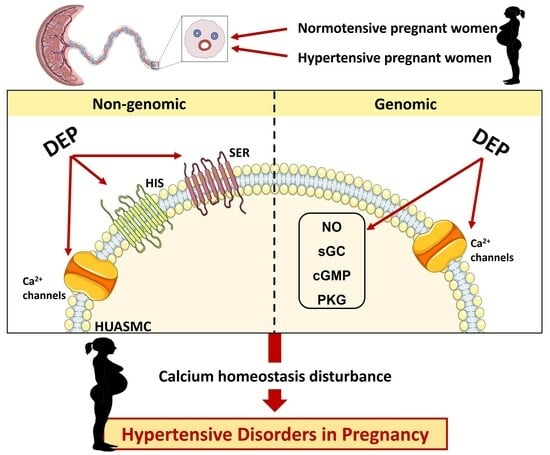-
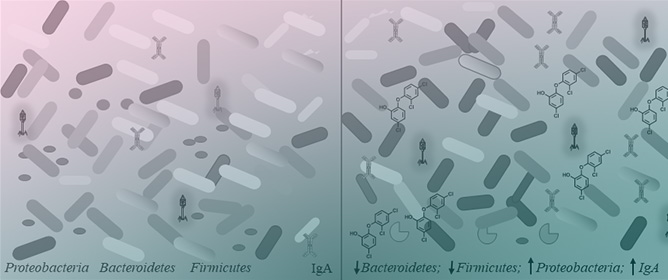 Early Developmental Exposure to Triclosan Impacts the Rat Microbiome
Early Developmental Exposure to Triclosan Impacts the Rat Microbiome -
 The Genotoxicity of Organic Extracts from Particulate Emissions Produced by Neat Gasoline (E0) and a Gasoline–Ethanol Blend (E15) in BEAS-2B Cells
The Genotoxicity of Organic Extracts from Particulate Emissions Produced by Neat Gasoline (E0) and a Gasoline–Ethanol Blend (E15) in BEAS-2B Cells -
 Persistent Organic Pollutants in Austrian Human Breast Milk Collected between 2013 and 2016
Persistent Organic Pollutants in Austrian Human Breast Milk Collected between 2013 and 2016 -
 Navigating the Complexities of Carcinogen-Induced Cancer Models
Navigating the Complexities of Carcinogen-Induced Cancer Models -
 Detailed Neurodegeneration Profiling in Elegant Nematodes
Detailed Neurodegeneration Profiling in Elegant Nematodes
Journal Description
Journal of Xenobiotics
Journal of Xenobiotics
is an international, peer-reviewed, open access journal on xenobiotics published quarterly online by MDPI (from Volume 10, Issue 1 - 2020).
- Open Access— free for readers, with article processing charges (APC) paid by authors or their institutions.
- High Visibility: indexed within Scopus, ESCI (Web of Science), PubMed, PMC, CAPlus / SciFinder, Embase, and other databases
- Journal Rank: CiteScore - Q2 (Pollution)
- Rapid Publication: manuscripts are peer-reviewed and a first decision is provided to authors approximately 21.7 days after submission; acceptance to publication is undertaken in 2.6 days (median values for papers published in this journal in the second half of 2023).
- Recognition of Reviewers: APC discount vouchers, optional signed peer review and reviewer names are published annually in the journal.
Impact Factor:
6.0 (2022);
5-Year Impact Factor:
5.0 (2022)
Latest Articles
Exposure to DEP Modifies the Human Umbilical Artery Vascular Resistance Contributing to Hypertension in Pregnancy
J. Xenobiot. 2024, 14(2), 497-515; https://doi.org/10.3390/jox14020030 - 18 Apr 2024
Abstract
Hypertensive disorders in pregnancy (HDP) are the most prevalent diseases during pregnancy. In addition to the already identified risk factors, exposure to environmental contaminants has been also considered a new one. Phthalates, which are classified as priority environmental pollutants due to their ubiquitousness
[...] Read more.
Hypertensive disorders in pregnancy (HDP) are the most prevalent diseases during pregnancy. In addition to the already identified risk factors, exposure to environmental contaminants has been also considered a new one. Phthalates, which are classified as priority environmental pollutants due to their ubiquitousness and endocrine disrupting properties, have been implicated in HDP in some epidemiological studies. Nevertheless, phthalates’ vascular impacts still need to be clarified. Thus, we aimed to understand the connection between phthalates exposure and the occurrence of gestational hypertension, as well as the pathway involved in the pathological vascular effects. We investigated diethyl phthalate’s (DEP) effect on the vascular reactivity of the human umbilical arteries (HUAs) from normotensive and hypertensive pregnant women. Both DEP’s nongenomic (within minutes effect) and genomic (24 h exposure to DEP) actions were evaluated, as well as the contribution of cyclic guanosine monophosphate and Ca2+ channel pathways. The results show that short-term exposure to DEP interferes with serotonin and histamine receptors, while after prolonged exposure, DEP seems to share the same vasorelaxant mechanism as estrogens, through the NO/sGC/cGMP/PKG signaling pathway, and to interfere with the L-type Ca2+ channels. Thus, the vascular effect induced by DEP is similar to that observed in HUA from hypertensive pregnancies, demonstrating that the development of HDP may be a consequence of DEP exposure.
Full article
(This article belongs to the Special Issue The Role of Endocrine-Disrupting Chemicals in the Human Health)
►
Show Figures
Open AccessArticle
Exploring the Effects of Graphene-Based Nanoparticles on Early Salmonids Cardiorespiratory Responses, Swimming and Nesting Behavior
by
Tomas Makaras, Magdalena Jakubowska-Lehrmann, Živilė Jurgelėnė and Sergej Šemčuk
J. Xenobiot. 2024, 14(2), 484-496; https://doi.org/10.3390/jox14020029 - 14 Apr 2024
Abstract
Graphene-based nanomaterials are exceptionally attractive for a wide range of applications, raising the likelihood of the release of graphene-containing nanoparticles into aquatic environments. The growing use of these carbon nanomaterials in different industries highlights the crucial need to investigate their environmental impact and
[...] Read more.
Graphene-based nanomaterials are exceptionally attractive for a wide range of applications, raising the likelihood of the release of graphene-containing nanoparticles into aquatic environments. The growing use of these carbon nanomaterials in different industries highlights the crucial need to investigate their environmental impact and evaluate potential risks to living organisms. The current investigation evaluated the nanotoxicity of graphene (nanoflakes) and graphene oxide (GO) nanoparticles on the cardiorespiratory responses (heart rate, gill ventilation frequency), as well as the swimming and nesting behavioral parameters of early stage larvae and juvenile salmonids. Both short-term (96 h) and long-term (23 days) exposure experiments were conducted using two common species: brown trout (Salmo trutta) and rainbow trout (Oncorhynchus mykiss). The findings demonstrated notable alterations in fish nesting behavior, swimming performance, and cardiorespiratory functions, indicating the potential toxicity of nanoparticles. This impact was observed at both physiological and whole-organismal levels in salmonids at early stages. Future investigations should explore different types of nanocarbons and their potential enduring effects on fish population structure, considering not only individual survival but also broader aspects of development, including feeding, reproductive, and other social dynamics.
Full article
(This article belongs to the Special Issue Selected Papers from the 10th International Conference on Environmental Management, Engineering, Planning and Economics (CEMEPE 2023) and SECOTOX Conference)
►▼
Show Figures
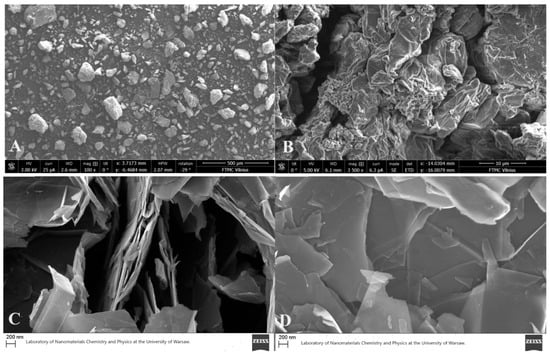
Figure 1
Open AccessArticle
Aquatic Fate and Ecotoxicology Effect of ZnS:Mn Quantum Dots on Chlorella vulgaris in Fresh Water
by
Bingbing Deng, Rania Maaloul, Sophie Nowak, Yann Sivry, Claude Yéprémian, Souad Ammar, Fayna Mammeri and Roberta Brayner
J. Xenobiot. 2024, 14(2), 467-483; https://doi.org/10.3390/jox14020028 - 26 Mar 2024
Abstract
With the increasing integration of nanomaterials into daily life, the potential ecotoxicological impacts of nanoparticles (NPs) have attracted increased attention from the scientific community. This study assessed the ecotoxicity of ZnS quantum dots (QDs) doped with varying molar concentrations of Mn2+ on
[...] Read more.
With the increasing integration of nanomaterials into daily life, the potential ecotoxicological impacts of nanoparticles (NPs) have attracted increased attention from the scientific community. This study assessed the ecotoxicity of ZnS quantum dots (QDs) doped with varying molar concentrations of Mn2+ on Chlorella vulgaris. The ZnS:Mn QDs were synthesized using the polyol method. The size of the ZnS:Mn QDs ranged from approximately 1.1 nm to 2 nm, while the aggregation size in Seine River water was 341 nm at pH 6 and 8. The presence of ZnS:Mn (10%) NPs exhibited profound toxicity to Chlorella vulgaris, with immediate reductions in viability (survival cells) from 71%, 60% to 51%, 52% in BG11 and Seine River water, respectively, at a concentration of 100 mg L−1 of ZnS:Mn (10%) NPs. Additionally, the ATP content in Chlorella vulgaris significantly decreased in Seine River water (by 20%) after 3 h of exposure to ZnS:Mn (10%) NPs. Concurrently, SOD activity significantly increased in Seine River water, indicating that the ZnS:Mn (10%) NPs induced ROS production and triggered an oxidative stress response in microalgae cells.
Full article
(This article belongs to the Special Issue Feature Papers in Ecotoxicology)
►▼
Show Figures
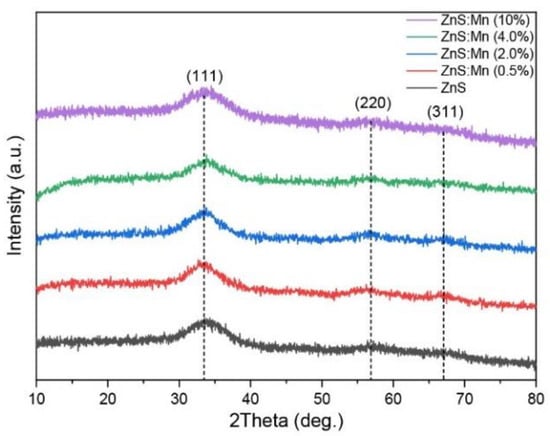
Figure 1
Open AccessArticle
Effects of Acute and Developmental Exposure to Bisphenol S on Chinese Medaka (Oryzias sinensis)
by
Bingying Li, Yongsi Huang, Duan Pi, Xiang Li, Yafen Guo, Zhiying Liang, Xiaohong Song, Junjie Wang and Xuegeng Wang
J. Xenobiot. 2024, 14(2), 452-466; https://doi.org/10.3390/jox14020027 - 22 Mar 2024
Abstract
Bisphenol S (BPS), one of the substitutes for bisphenol A (BPA), is widely used in various commodities. The BPS concentrations in surface water have gradually increased in recent years, making it a predominant bisphenol analogue in the aquatic environment and raising concerns about
[...] Read more.
Bisphenol S (BPS), one of the substitutes for bisphenol A (BPA), is widely used in various commodities. The BPS concentrations in surface water have gradually increased in recent years, making it a predominant bisphenol analogue in the aquatic environment and raising concerns about its health and ecological effects on aquatic organisms. For this study, we conducted a 96 h acute toxicity test and a 15-day developmental exposure test to assess the adverse effects of BPS exposure in Chinese medaka (Oryzias sinensis), a new local aquatic animal model. The results indicate that the acute exposure of Chinese medaka embryos to BPS led to relatively low toxicity. However, developmental exposure to BPS was found to cause developmental abnormalities, such as decreased hatching rate and body length, at 15 dpf. A transcriptome analysis showed that exposure to different concentrations of bisphenol S often induced different reactions. In summary, environmental concentrations of BPS can have adverse effects on the hatching and physical development of Chinese medaka, and further attention needs to be paid to the potential toxicity of environmental BPS.
Full article
(This article belongs to the Section Ecotoxicology)
►▼
Show Figures
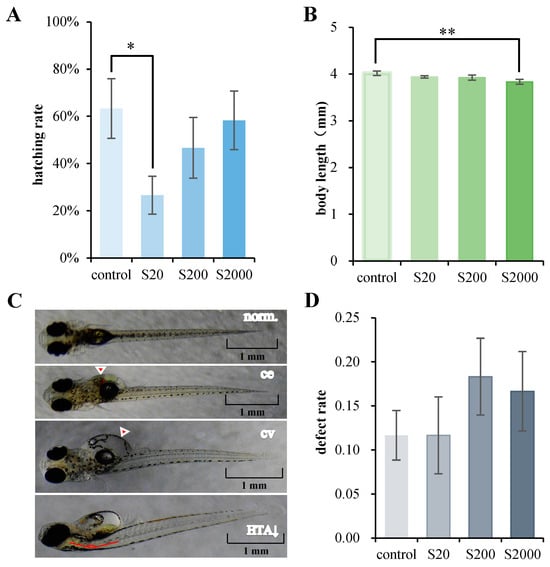
Figure 1
Open AccessReview
Bamboo-Based Biochar: A Still Too Little-Studied Black Gold and Its Current Applications
by
Silvana Alfei and Omar Ginoble Pandoli
J. Xenobiot. 2024, 14(1), 416-451; https://doi.org/10.3390/jox14010026 - 20 Mar 2024
Cited by 1
Abstract
Biochar (BC), also referred to as “black gold”, is a carbon heterogeneous material rich in aromatic systems and minerals, preparable by the thermal decomposition of vegetable and animal biomasses in controlled conditions and with clean technology. Due to its adsorption ability and presence
[...] Read more.
Biochar (BC), also referred to as “black gold”, is a carbon heterogeneous material rich in aromatic systems and minerals, preparable by the thermal decomposition of vegetable and animal biomasses in controlled conditions and with clean technology. Due to its adsorption ability and presence of persistent free radicals (PFRs), BC has demonstrated, among other uses, great potential in the removal of environmental organic and inorganic xenobiotics. Bamboo is an evergreen perennial flowering plant characterized by a short five-year growth period, fast harvesting, and large production in many tropical and subtropical countries worldwide, thus representing an attractive, low-cost, eco-friendly, and renewable bioresource for producing BC. Due to their large surface area and increased porosity, the pyrolyzed derivatives of bamboo, including bamboo biochar (BBC) or activated BBC (ABBC), are considered great bio-adsorbent materials for removing heavy metals, as well as organic and inorganic contaminants from wastewater and soil, thus improving plant growth and production yield. Nowadays, the increasing technological applications of BBC and ABBC also include their employment as energy sources, to catalyze chemical reactions, to develop thermoelectrical devices, as 3D solar vapor-generation devices for water desalination, and as efficient photothermal-conversion devices. Anyway, although it has great potential as an alternative biomass to wood to produce BC, thus paving the way for new bio- and circular economy solutions, the study of bamboo-derived biomasses is still in its infancy. In this context, the main scope of this review was to support an increasing production of BBC and ABBC and to stimulate further studies about their possible applications, thus enlarging the current knowledge about these materials and allowing their more rational, safer, and optimized application. To this end, after having provided background concerning BC, its production methods, and its main applications, we have reviewed and discussed the main studies on BBC and ABBC and their applications reported in recent years.
Full article
(This article belongs to the Special Issue Feature Papers in Ecotoxicology)
►▼
Show Figures
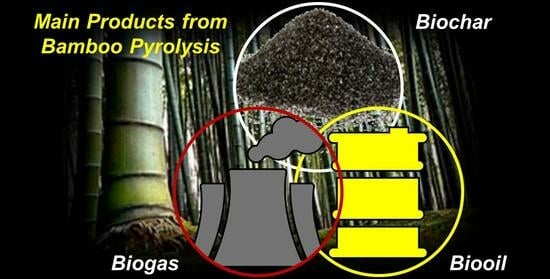
Graphical abstract
Open AccessArticle
An Exploratory Investigation of Organic Chemicals Detected in Baby Teeth: Differences in Children with and without Autism
by
Raymond F. Palmer
J. Xenobiot. 2024, 14(1), 404-415; https://doi.org/10.3390/jox14010025 - 14 Mar 2024
Abstract
Autism spectrum disorder (ASD) is a behaviorally defined neurodevelopmental disorder characterized by deficits in language, communication, and social function with an estimated prevalence rate of between 1 in 30 and 44 U.S. births. Gene/environment (G × E) interactions are widely regarded as the
[...] Read more.
Autism spectrum disorder (ASD) is a behaviorally defined neurodevelopmental disorder characterized by deficits in language, communication, and social function with an estimated prevalence rate of between 1 in 30 and 44 U.S. births. Gene/environment (G × E) interactions are widely regarded as the most probable explanation for idiopathic ASD, especially because some genes are selectively targeted by various environmental xenobiotics. Because deciduous teeth are a likely biomarker of in utero exposure, the present study investigated if the quantity of chemicals found in deciduous teeth differs between children with and without ASD. Twenty-two deciduous teeth from children with ASD and 20 teeth from typically developed children were prepared and analyzed using THE Two-Dimensional Gas Chromatography Time-of-Flight Mass Spectrometer (GC × GC-TOF MS) with ChromaTOF version 23H2 software and Agilent 7890 gas chromatograph. The autism sample had significantly more chemicals in their teeth than the typical developing sample (99.4 vs. 80.7, respectively) (p < 0.0001). The majority of chemicals were identified as phthalates, plasticizers, pesticides, preservatives, or intermediary solvents used in the production of fragranced personal care or cleaning products or flavoring agents in foods. The known toxic analytes reported in this study are likely biomarkers of developmental exposure. Why there were greater concentrations of toxic chemicals in the teeth that came from children with ASD is unclear. A further understanding of the cavalcade of multiple biological system interactions (Interactome) could help with future efforts to reduce risks. Notwithstanding, the avoidance of pesticides, plastics, and scented personal care products may be warranted under the precautionary principle rule.
Full article
(This article belongs to the Special Issue Environmental Conditions and Autism Spectrum Disorders)
►▼
Show Figures
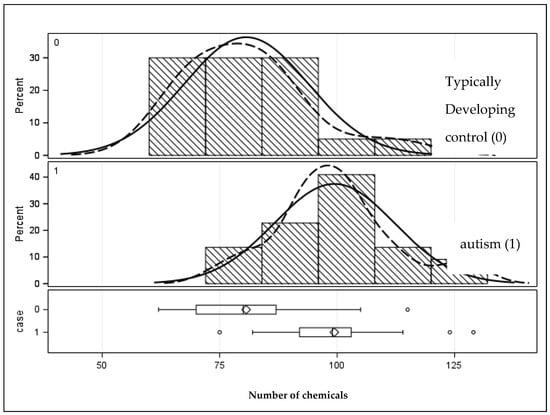
Figure 1
Open AccessReview
Modulation of the Mas-Related G Protein-Coupled Receptor X2 (MRGPRX2) by Xenobiotic Compounds and Its Relevance to Human Diseases
by
Alicja Dziadowiec, Iwona Popiolek, Mateusz Kwitniewski and Grzegorz Porebski
J. Xenobiot. 2024, 14(1), 380-403; https://doi.org/10.3390/jox14010024 - 13 Mar 2024
Abstract
Mast cells (MCs) are immune cells that reside in tissues; particularly in the skin, and in the gastrointestinal and respiratory tracts. In recent years, there has been considerable interest in the Mas-Related G Protein-Coupled Receptor X2 (MRGPRX2), which is present on the surface
[...] Read more.
Mast cells (MCs) are immune cells that reside in tissues; particularly in the skin, and in the gastrointestinal and respiratory tracts. In recent years, there has been considerable interest in the Mas-Related G Protein-Coupled Receptor X2 (MRGPRX2), which is present on the surface of MCs and can be targeted by multiple exogenous and endogenous ligands. It is potentially implicated in non-IgE-mediated pseudoallergic reactions and inflammatory conditions such as asthma or atopic dermatitis. In this paper, we review natural products and herbal medicines that may potentially interact with MRGPRX2. They mainly belong to the classes of polyphenols, flavonoids, coumarins, and alkaloids. Representative compounds include rosmarinic acid, liquiritin from licorice extract, osthole, and sinomenine, respectively. While evidence-based medicine studies are still required, these compounds have shown diverse effects, such as antioxidant, analgesic, anti-inflammatory, or neuroprotective. However, despite potential beneficial effects, their use is also burdened with risks of fatal reactions such as anaphylaxis. The role of MRGPRX2 in these reactions is a subject of debate. This review explores the literature on xenobiotic compounds from herbal medicines that have been shown to act as MRGPRX2 ligands, and their potential clinical significance.
Full article
(This article belongs to the Section Natural Products/Herbal Medicines)
►▼
Show Figures
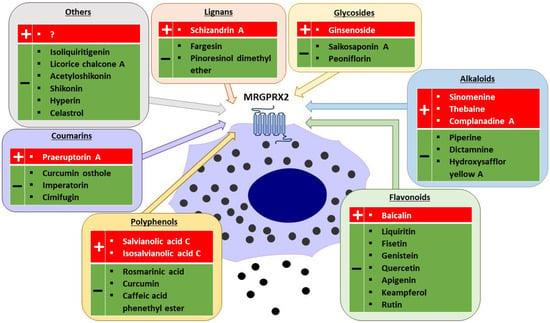
Figure 1
Open AccessArticle
Air Pollution and Primary DNA Damage among Zagreb (Croatia) Residents: A Cross-Sectional Study
by
Marko Gerić, Gordana Pehnec, Katarina Matković, Jasmina Rinkovec, Ivana Jakovljević, Ranka Godec, Silva Žužul, Ivan Bešlić, Ante Cvitković, Luka Delić, Pascal Wild, Irina Guseva Canu, Nancy B. Hopf and Goran Gajski
J. Xenobiot. 2024, 14(1), 368-379; https://doi.org/10.3390/jox14010023 - 13 Mar 2024
Abstract
More than eight million premature deaths annually can be attributed to air pollution, with 99% of the world’s population residing in areas below recommended air quality standards. Hence, the present study aimed to examine the association between primary DNA damage and air pollution
[...] Read more.
More than eight million premature deaths annually can be attributed to air pollution, with 99% of the world’s population residing in areas below recommended air quality standards. Hence, the present study aimed to examine the association between primary DNA damage and air pollution data among 123 participants enrolled between 2011 and 2015 in Zagreb, Croatia. While most measured air pollutants adhered to regulatory limits, benzo[a]pyrene concentrations bound to PM10 exceeded them. Factorial analysis narrowed down air pollution data to four exposure factors (particulate matter, two metal factors, and other pollutants). Despite the absence of significant positive associations between modeled air pollution exposure factors and comet assay descriptors (tail length, tail intensity, tail moment, and highly damaged nuclei), the critical health implications of air pollution warrant further investigations, particularly with biomarkers of exposure and different biomarkers of effect in populations facing air pollution exposure.
Full article
(This article belongs to the Topic Disease Risks and Toxic Pathway from Environmental Chemical Exposure)
Open AccessArticle
Assessing Chemical Intolerance in Parents Predicts the Risk of Autism and ADHD in Their Children
by
Raymond F. Palmer, David Kattari, Rodolfo Rincon and Claudia S. Miller
J. Xenobiot. 2024, 14(1), 350-367; https://doi.org/10.3390/jox14010022 - 05 Mar 2024
Abstract
Background: We sought to replicate our 2015 findings linking chemical intolerance in parents with the risk of their children developing autism and/or ADHD. Drawing upon our 2021 discovery of a strong association between chemical intolerance and mast cells, we propose an explanation for
[...] Read more.
Background: We sought to replicate our 2015 findings linking chemical intolerance in parents with the risk of their children developing autism and/or ADHD. Drawing upon our 2021 discovery of a strong association between chemical intolerance and mast cells, we propose an explanation for this link. Methods: In a population-based survey of U.S. adults, we used the internationally validated Quick Environmental Exposure and Sensitivity Inventory (QEESI) to assess symptom severity and chemical intolerance. Parents were asked how many of their biological children had been diagnosed with autism and/or ADHD. Results: Parents with chemical intolerance scores in the top versus bottom tenth percentile had 5.7 times the risk of reporting a child with autism and 2.1 times for ADHD. Conclusions: High chemical intolerance scores among parents of children with autism, coupled with our 2021 discovery of mast cell activation as a plausible biomechanism for chemical intolerance, suggest that (1) the QEESI can identify individuals at increased risk, (2) environmental counseling may reduce personal exposures and risk, and (3) the global rise in autism and ADHD may be due to fossil-fuel-derived and biogenic toxicants epigenetically “turning on” or “turning off” critical mast cell genes that can be transmitted transgenerationally. It is important to note that this study was observational in nature; as such, further research is needed using controlled trials to confirm causality and explore the proposed mechanism.
Full article
(This article belongs to the Special Issue Environmental Conditions and Autism Spectrum Disorders)
►▼
Show Figures
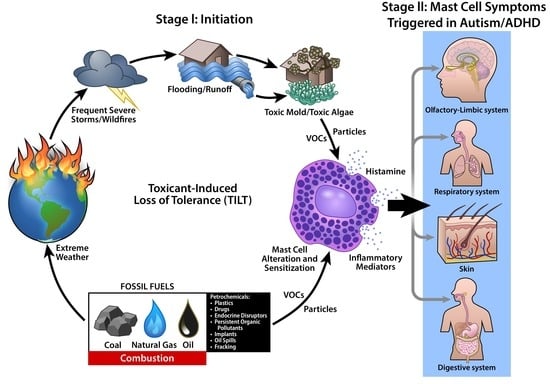
Graphical abstract
Open AccessArticle
Mitigation of Salt Stress in Rice by the Halotolerant Plant Growth-Promoting Bacterium Enterobacter asburiae D2
by
Zican Ning, Kexin Lin, Mengya Gao, Xiao Han, Qingjie Guan, Xiang Ji, Shuyu Yu and Lei Lu
J. Xenobiot. 2024, 14(1), 333-349; https://doi.org/10.3390/jox14010021 - 01 Mar 2024
Abstract
Salinity is a major abiotic stress that seriously affects crop growth worldwide. In this work, we aimed to isolate potential halotolerant plant growth-promoting rhizobacteria (PGPR) to mitigate the adverse impacts of salt stress in rice. An isolate, D2, with multiple plant growth-promoting (PGP)
[...] Read more.
Salinity is a major abiotic stress that seriously affects crop growth worldwide. In this work, we aimed to isolate potential halotolerant plant growth-promoting rhizobacteria (PGPR) to mitigate the adverse impacts of salt stress in rice. An isolate, D2, with multiple plant growth-promoting (PGP) characteristics was identified as Enterobacter asburiae D2. Strain D2 could produce indole-3-acetic acid and siderophore. It also exhibited phosphate solubilization and 1-aminocyclopropane-1-carboxylic deaminase activity. Genome analysis further provided insights into the molecular mechanism of its PGP abilities. Strain D2 inoculation efficiently stimulated rice growth under both normal and saline conditions. Compared with the non-inoculated plants, a significant increase in plant height (18.1–34.7%), root length (25.9–57.1%), root dry weight (57.1–150%), and shoot dry weight (17.3–50.4%) was recorded in inoculated rice seedlings. Meanwhile, rice seedlings inoculated with strain D2 showed improvement in chlorophyll and proline content, while the oxidant damage was reduced in these plants in comparison with the control group. Moreover, the K+/Na+ ratio of the inoculated rice seedlings exposed to NaCl and Na2CO3 was higher than that of the uninoculated groups. These results imply that Enterobacter asburiae D2 is a potential PGPR that can be used for alleviation of salt stress in rice.
Full article
(This article belongs to the Special Issue Plant Biostimulants - a Promising Tool in Organic Farming)
►▼
Show Figures
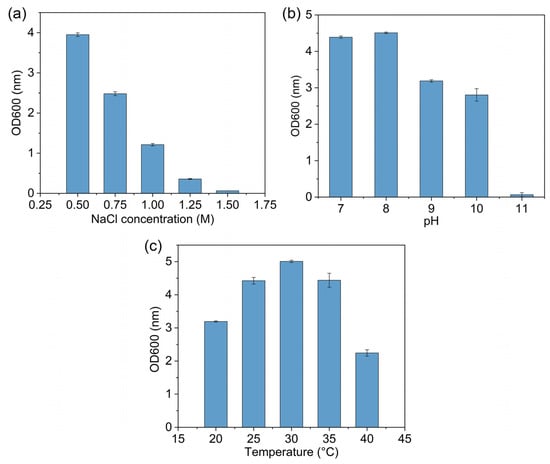
Figure 1
Open AccessArticle
Spironolactone Induces Vasodilation by Endothelium-Dependent Mechanisms Involving NO and by Endothelium-Independent Mechanisms Blocking Ca2+ Channels
by
Margarida Lorigo, João Amaro and Elisa Cairrao
J. Xenobiot. 2024, 14(1), 320-332; https://doi.org/10.3390/jox14010020 - 01 Mar 2024
Abstract
►▼
Show Figures
Background: Spironolactone (SPI) is a diuretic widely used to treat cardiovascular diseases (CVD) and is non-specific for mineralocorticoid receptors (MR) and with an affinity for progesterone (PR) and androgen (AR) receptors. Since 2009, it has been suggested that pharmaceuticals are emerging contaminants (called
[...] Read more.
Background: Spironolactone (SPI) is a diuretic widely used to treat cardiovascular diseases (CVD) and is non-specific for mineralocorticoid receptors (MR) and with an affinity for progesterone (PR) and androgen (AR) receptors. Since 2009, it has been suggested that pharmaceuticals are emerging contaminants (called EDC), and recently, it was reported that most EDC are AR and MR antagonists and estrogen receptors (ER) agonists. Concerning SPI, endocrine-disrupting effects were observed in female western mosquitofish, but there are still no data regarding the SPI effects as a possible human EDC. Methods: In this work, aortic rings were used to analyze the contractility effects of SPI and the mode of action concerning the involvement of Ca2+ channels and endothelial pathways. Moreover, cytotoxic effects were analyzed by MTT assays. Results: SPI induces vasodilation in the rat aorta by endothelium-dependent mechanisms involving NO and by endothelium-independent mechanisms blocking Ca2+ channels. Moreover, a non-monotonic effect characteristic of EDC was observed for SPI-induced decrease in cell viability. Conclusions: Our findings suggest that SPI may act as an EDC at a human level. However, ex vivo studies with human arteries should be carried out to better understand this drug’s implications for human health and future generations.
Full article
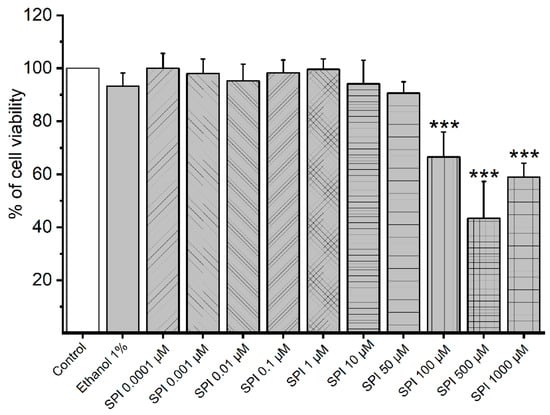
Figure 1
Open AccessArticle
Xenobiotics Triggering Acute Intermittent Porphyria and Their Effect on Mouse Brain Respiratory Complexes
by
Johanna Romina Zuccoli, María del Carmen Martínez, Pablo Vallecorsa and Ana María Buzaleh
J. Xenobiot. 2024, 14(1), 308-319; https://doi.org/10.3390/jox14010019 - 27 Feb 2024
Abstract
►▼
Show Figures
Heme enzyme dysfunction causes a group of diseases called porphyrias. Particularly, a decrease in porphobilinogen deaminase, involved in the third step of heme biosynthesis, leads to acute intermittent porphyria (AIP). Considering our previous works demonstrating the multiplicity of brain metabolisms affected by porphyrinogenic
[...] Read more.
Heme enzyme dysfunction causes a group of diseases called porphyrias. Particularly, a decrease in porphobilinogen deaminase, involved in the third step of heme biosynthesis, leads to acute intermittent porphyria (AIP). Considering our previous works demonstrating the multiplicity of brain metabolisms affected by porphyrinogenic agents, this study aimed to elucidate whether they cause any alteration on the mitochondrial respiratory chain. The activities of respiratory chain complexes (I to IV) were measured in encephalon mitochondria of CF1 male mice receiving volatile anesthetics: isoflurane (2 mL/kg) and sevoflurane (1.5 mL/kg), ethanol (30%), allylisopropylacetamide (AIA) (350 mg/kg), and barbital (167 mg/kg). Moreover, they were compared versus animals with pathological levels of 5-aminolevulinic acid (ALA, 40 mg/kg). Complex I–III activity was induced by isoflurane and decreased by AIA, ethanol, and ALA. Complex II–III activity was increased by sevoflurane and decreased by isoflurane and AIA. Complex II activity was increased by sevoflurane and barbital and decreased by AIA, ethanol, and ALA. Complex IV activity was increased by barbital and ALA and decreased by sevoflurane. The damage to the respiratory chain by ALA could be reflecting the pathophysiological condition of patients with AIP. Better understanding the broad effect of porphyrinogenic drugs and the mechanisms acting on the onset of AIP is vital in translational medicine.
Full article
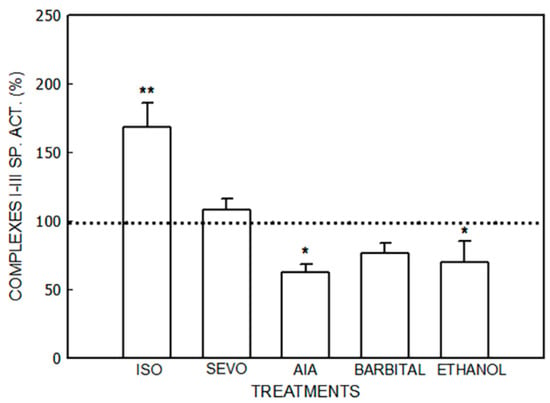
Figure 1
Open AccessArticle
The Complete Genome Sequence of Bacillus toyonensis Cbmb3 with Polyvinyl Chloride-Degrading Properties
by
Dandan Wang, Hong Yu, Xinbei Liu, Li Sun, Xijian Liu, Ruilong Hu, Chao Wang, Yuping Zhuge and Zhihong Xie
J. Xenobiot. 2024, 14(1), 295-307; https://doi.org/10.3390/jox14010018 - 26 Feb 2024
Abstract
The accumulation of high amounts of plastic waste in the environment has raised ecological and health concerns, particularly in croplands, and biological degradation presents a promising approach for the sustainable treatment of this issue. In this study, a polyvinyl chloride (PVC)-degrading bacterium was
[...] Read more.
The accumulation of high amounts of plastic waste in the environment has raised ecological and health concerns, particularly in croplands, and biological degradation presents a promising approach for the sustainable treatment of this issue. In this study, a polyvinyl chloride (PVC)-degrading bacterium was isolated from farmland soil samples attached to waste plastic, utilizing PVC as the sole carbon source. The circular chromosome of the strain Cbmb3, with a length of 5,768,926 bp, was subsequently sequenced. The average GC content was determined to be 35.45%, and a total of 5835 open reading frames were identified. The strain Cbmb3 was designated as Bacillus toyonensis based on phylogenomic analyses and genomic characteristics. The bioinformatic analysis of the Cbmb3 genome revealed putative genes encoding essential enzymes involved in PVC degradation. Additionally, the potential genomic characteristics associated with phytoprobiotic effects, such as the synthesis of indole acetic acid and secondary metabolite synthesis, were also revealed. Overall, the present study provides the first complete genome of Bacillus toyonensis with PVC-degrading properties, suggesting that Cbmb3 is a potential strain for PVC bioremediation and application.
Full article
(This article belongs to the Special Issue Microplastics in Soils: Occurrence, Sources, Contaminant Vectors, and Effects on Soil Properties)
►▼
Show Figures
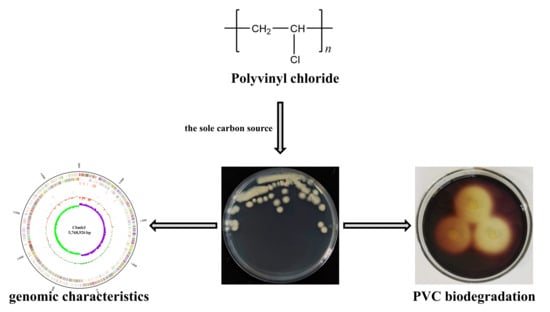
Graphical abstract
Open AccessArticle
Iron Oxide (Magnetite)-Based Nanobiomaterial with Medical Applications—Environmental Hazard Assessment Using Terrestrial Model Species
by
Susana I. L. Gomes, Janeck J. Scott-Fordsmand and Mónica J. B. Amorim
J. Xenobiot. 2024, 14(1), 285-294; https://doi.org/10.3390/jox14010017 - 22 Feb 2024
Abstract
Nanobiomaterials (NBMs) have tremendous potential applications including in cancer diagnosis and treatment. However, the health and environmental effects of NBMs must be thoroughly assessed to ensure safety. Fe3O4 (magnetite) nanoparticles coated with polyethylene glycol (PEG) and poly (lactic-co-glycolic acid) (PLGA)
[...] Read more.
Nanobiomaterials (NBMs) have tremendous potential applications including in cancer diagnosis and treatment. However, the health and environmental effects of NBMs must be thoroughly assessed to ensure safety. Fe3O4 (magnetite) nanoparticles coated with polyethylene glycol (PEG) and poly (lactic-co-glycolic acid) (PLGA) were one of the focus NBMs within the EU project BIORIMA. Fe3O4 PEG-PLGA has been proposed to be used as a contrast agent in magnetic resonance imaging for the identification of solid tumors and has revealed low cytotoxicity in several cell lines. However, the effects of Fe3O4 PEG-PLGA have not been assessed in terrestrial environments, the eventual final sink of most materials. In the present study, the effects of Fe3O4 PEG-PLGA and its precursor, (un-coated) Fe3O4 NMs, were assessed in soil model invertebrates Enchytraeus crypticus (Oligochaeta) and Folsomia candida (Collembola). The endpoints were survival, reproduction, and size, based on the standard OECD test (28 days) and its extension (56 days). The results showed no toxicity for any of the endpoints evaluated, indicating that the NBM Fe3O4 PEG-PLGA poses no unacceptable risk to the terrestrial environment.
Full article
(This article belongs to the Section Ecotoxicology)
►▼
Show Figures
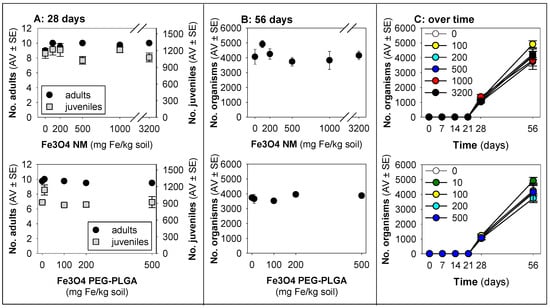
Figure 1
Open AccessArticle
The Effect of Granulometry of Carbonaceous Materials and Application Rates on the Availability of Soil-Bound Dichlorodiphenyltrichloroethane (DDT) and Its Metabolites
by
Farida Amutova, Ronagul Turganova, Gaukhar Konuspayeva, Sarra Gaspard, Aigerim Mamirova, Florentin Michaux, Pamela Hartmeyer, Claire Soligot, Leyla Djansugurova, Stefan Jurjanz and Matthieu Delannoy
J. Xenobiot. 2024, 14(1), 267-284; https://doi.org/10.3390/jox14010016 - 11 Feb 2024
Cited by 1
Abstract
►▼
Show Figures
Biochars (BCs) and activated carbons (ACs) are well-known carbon-rich materials that are being increasingly studied in environmental sciences for water treatment applications to remediate pollutant sequestration in soil. This study aimed to assess the impact of Sargasso BC particle size and amendment rate
[...] Read more.
Biochars (BCs) and activated carbons (ACs) are well-known carbon-rich materials that are being increasingly studied in environmental sciences for water treatment applications to remediate pollutant sequestration in soil. This study aimed to assess the impact of Sargasso BC particle size and amendment rate on the environmental availability of DDT and DDT metabolites in two distinct Kazakh soils. These two soils were collected in the vicinity of storehouse facilities in Kyzylkairat and Beskainar that store banned pesticides. They presented very distinct concentration levels of DDT and DDT metabolites. Three different types of carbonaceous matrices were tested: Sargasso BC and two commercial ACs (ORBOTM and DARCO©). For the granulometry effect, Sargasso BC was ground, and two particle sizes were tested (<150 µm, >150 µm) and compared to an unground material. Four distinct application rates were tested (0.25, 0.5, 1, and 2% (w/w)). After a three-month maturation period, environmental availability was assessed using an ISO/DIS 16751, part B-modified methodology. Interestingly, the best reductions in DDT environmental availability were obtained with the finest particle size (both ACs and Sargasso BC < 150 µm). More specifically, the effectiveness of the strategy seemed to depend on many factors. Firstly, a clear soil effect was demonstrated, suggesting that the more contaminated the soil, the more efficient this strategy may be. Secondly, the results showed that an increase in the amendment rate improves the immobilization of DDT and DDT metabolites. The sequestration material demonstrated different efficiency values (up to 58 ± 4% for Sargasso BC < 150 µm and 85 ± 4% for DARCO at a 2% application rate). Finally, a clear molecule effect was displayed, demonstrating the following immobilization order: p,p’-DDE > p,p’-DDD > p,p’-DDT > o,p’-DDT.
Full article
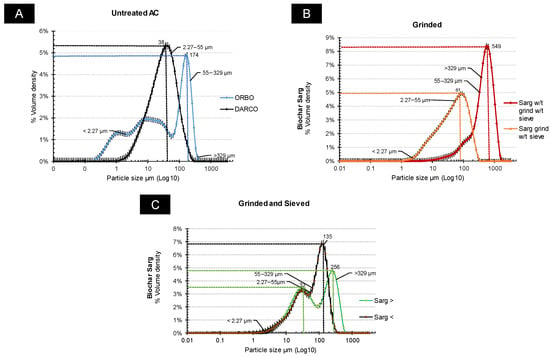
Figure 1
Open AccessArticle
Persistent Organic Pollutants in Austrian Human Breast Milk Collected between 2013 and 2016
by
Christina Hartmann, Andreas-Marius Kaiser, Wolfgang Moche, Stefan Weiss, Wolfgang Raffesberg, Sigrid Scharf, Klaudia Graf-Rohrmeister, Margarita Thanhaeuser, Nadja Haiden and Maria Uhl
J. Xenobiot. 2024, 14(1), 247-266; https://doi.org/10.3390/jox14010015 - 07 Feb 2024
Abstract
Breast milk holds an immense nutritional value as it contains health-promoting substances in a unique, optimal form. Additionally, breast milk’s significance extends to health and environmental protection, as it serves as an indicator of both maternal and infant exposure. In this study, breast
[...] Read more.
Breast milk holds an immense nutritional value as it contains health-promoting substances in a unique, optimal form. Additionally, breast milk’s significance extends to health and environmental protection, as it serves as an indicator of both maternal and infant exposure. In this study, breast milk samples collected in 2013 and in 2014–2016 from mothers in Vienna (Austria) were analysed for polybrominated diphenyl ethers (PBDE) and per- and polyfluoroalkyl substances (PFAS), as well as further substances which have been listed under the Stockholm Convention on Persistent Organic Pollutants (POPs) due to their persistent, bioaccumulative and toxic properties. The total concentration of the PBDE congeners in the samples (n = 18, sampled 2013) ranged from 0.055 to 52 ng/g lipid, and from 0.002 to 2.5 ng/g breast milk. In the pooled sample, the sum of PBDEs was detected at a level of 4.4 ng/g lipid. Based on the 2014–2016 study population, certain PFAS were detected in all samples (n = 40). Exposure to the sum of four specific PFAS including perfluorooctanesulphonate (PFOS), perfluorooctanoic acid (PFOA), perfluoro-n-nonanoic acid (PFNA) and perfluoro-1-hexanesulfonate (PFHxS) ranged between 0.014 and 0.12 ng/L breast milk. In the pooled sample, PFOS and PFOA were found in concentrations of 0.025 ng/g and of 0.045 ng/g, respectively. In addition, the first generation of POPs, mainly organochlorine compounds, was measured in a pooled sample of breast milk from participants sampled in 2014–2016 as part of the WHO/UNEP breast milk monitoring program and compared to the POPs measured in pooled samples collected in 1987/1988 and 1992/1993, respectively. Therefore, this paper demonstrates the effectiveness of the Stockholm Convention on POPs by comparing the Austrian results from the WHO/UNEP global breast milk study from 1987 to 2016. However, the data also show that, despite these reductions, health-relevant levels are still being reached, particularly in terms of children’s health when the presence of the new generation of POPs, such as PBDEs and PFAS, in human breast milk is taken into account.
Full article
(This article belongs to the Special Issue Journal of Xenobiotics: Feature Papers)
►▼
Show Figures
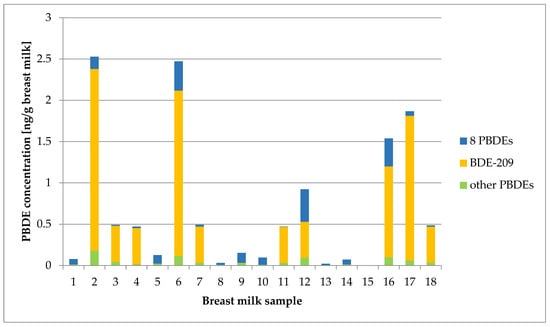
Figure 1
Open AccessReview
Phenolic Compounds of Therapeutic Interest in Neuroprotection
by
José Manuel Nájera-Maldonado, Ricardo Salazar, Patricia Alvarez-Fitz, Macdiel Acevedo-Quiroz, Eugenia Flores-Alfaro, Daniel Hernández-Sotelo, Mónica Espinoza-Rojo and Mónica Ramírez
J. Xenobiot. 2024, 14(1), 227-246; https://doi.org/10.3390/jox14010014 - 06 Feb 2024
Cited by 1
Abstract
The number of elderly people is projected to double in the next 50 years worldwide, resulting in an increased prevalence of neurodegenerative diseases. Aging causes changes in brain tissue homeostasis, thus contributing to the development of neurodegenerative disorders. Current treatments are not entirely
[...] Read more.
The number of elderly people is projected to double in the next 50 years worldwide, resulting in an increased prevalence of neurodegenerative diseases. Aging causes changes in brain tissue homeostasis, thus contributing to the development of neurodegenerative disorders. Current treatments are not entirely effective, so alternative treatments or adjuvant agents are being actively sought. Antioxidant properties of phenolic compounds are of particular interest for neurodegenerative diseases whose psychopathological mechanisms strongly rely on oxidative stress at the brain level. Moreover, phenolic compounds display other advantages such as the permeability of the blood–brain barrier (BBB) and the interesting molecular mechanisms that we reviewed in this work. We began by briefly outlining the physiopathology of neurodegenerative diseases to understand the mechanisms that result in irreversible brain damage, then we provided an overall classification of the phenolic compounds that would be addressed later. We reviewed in vitro and in vivo studies, as well as some clinical trials in which neuroprotective mechanisms were demonstrated in models of different neurodegenerative diseases such as amyotrophic lateral sclerosis (ALS), Alzheimer’s disease (AD), Parkinson’s disease (PD), ischemia, and traumatic brain injury (TBI).
Full article
(This article belongs to the Section Natural Products/Herbal Medicines)
►▼
Show Figures
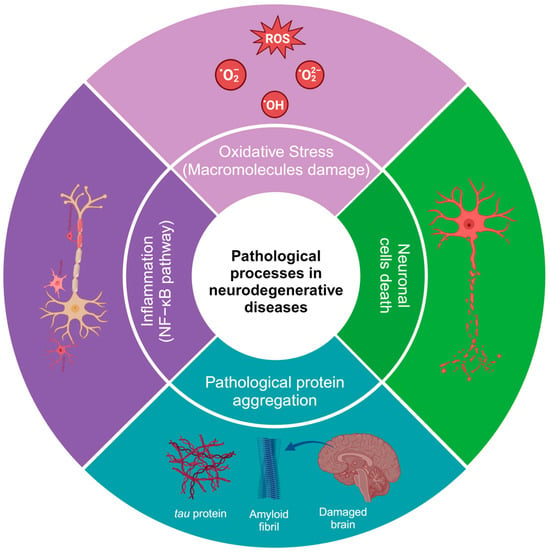
Figure 1
Open AccessFeature PaperArticle
Pyriproxyfen Contamination in Daphnia magna: Identifying Early Warning Biomarkers
by
Beatriz Salesa, Javier Torres-Gavilá, María Dolores Ferrando-Rodrigo and Encarnación Sancho
J. Xenobiot. 2024, 14(1), 214-226; https://doi.org/10.3390/jox14010013 - 02 Feb 2024
Abstract
Pyriproxyfen is an insecticide currently employed in numerous countries for the management of agricultural and indoor pests. Several studies indicate that this insecticide has been detected in multiple rivers, with concentrations reaching as high as 99.59 ng/L in the Júcar River in Spain.
[...] Read more.
Pyriproxyfen is an insecticide currently employed in numerous countries for the management of agricultural and indoor pests. Several studies indicate that this insecticide has been detected in multiple rivers, with concentrations reaching as high as 99.59 ng/L in the Júcar River in Spain. Therefore, the determination of some biochemical and genetic effects of this insecticide on aquatic organisms could serve as an early warning mechanism to identify potential disruptions in various biomarkers. Based on this, Daphnia magna organisms were exposed to pyriproxyfen sublethal concentrations for 21 days. Some biochemical parameters, including cholesterol, triglycerides, glucose, lactate, and LDH activity, were determined. Additionally, some genetic biomarkers associated with oxidative stress, heat shock proteins, lipid metabolism, hemoglobin, metallothioneins, and vitellogenin synthesis were evaluated in daphnids exposed to the insecticide for 21 days. LDH activity increased significantly in those daphnids exposed to the highest insecticide concentration (14.02 µg/L), while cholesterol levels decreased significantly. In contrast, glucose, total proteins, and triglycerides remained unaffected in D. magna exposed to pyriproxyfen. On the other hand, exposure to the insecticide led to notable alterations in gene expression among individuals. Specifically, genes associated with lipid metabolism and reproduction exhibited a significant reduction in gene expression. Fabd expression was decreased by approximately 20% in exposed daphnids, while vtg expression was suppressed as much as 80% when compared to control values. Furthermore, it was observed that the hgb1 and hgb2 genes, associated with hemoglobin synthesis, exhibited significant overexpression. Notably, the dysfunction observed in both hemoglobin genes was linked to an increase in pigmentation in Daphnia magna during the course of the experiment. These alterations in gene expression could serve as effective indicators of early contamination even at low pesticide concentrations.
Full article
(This article belongs to the Special Issue Selected Papers from the 10th International Conference on Environmental Management, Engineering, Planning and Economics (CEMEPE 2023) and SECOTOX Conference)
►▼
Show Figures
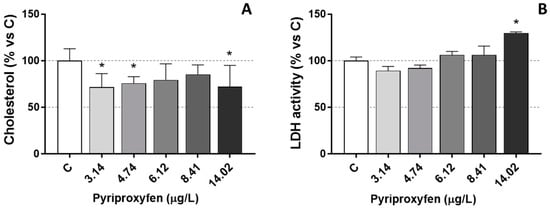
Figure 1
Open AccessArticle
Early Developmental Exposure to Triclosan Impacts Fecal Microbial Populations, IgA and Functional Activities of the Rat Microbiome
by
Mohamed Lahiani, Kuppan Gokulan, Vicki Sutherland, Helen C. Cunny, Carl E. Cerniglia and Sangeeta Khare
J. Xenobiot. 2024, 14(1), 193-213; https://doi.org/10.3390/jox14010012 - 01 Feb 2024
Abstract
Triclosan (TCS), a broad-spectrum antibacterial chemical, is detected in human urine, breast milk, amniotic fluid, and feces; however, little is known about its impact on the intestinal microbiome and host mucosal immunity during pregnancy and early development. Pregnant female rats were orally gavaged
[...] Read more.
Triclosan (TCS), a broad-spectrum antibacterial chemical, is detected in human urine, breast milk, amniotic fluid, and feces; however, little is known about its impact on the intestinal microbiome and host mucosal immunity during pregnancy and early development. Pregnant female rats were orally gavaged with TCS from gestation day (GD) 6 to postpartum (PP) day 28. Offspring were administered TCS from postnatal day (PND) 12 to 28. Studies were conducted to assess changes in the intestinal microbial population (16S-rRNA sequencing) and functional analysis of microbial genes in animals exposed to TCS during pregnancy (GD18), and at PP7, PP28 and PND28. Microbial abundance was compared with the amounts of TCS excreted in feces and IgA levels in feces. The results reveal that TCS decreases the abundance of Bacteroidetes and Firmicutes with a significant increase in Proteobacteria. At PND28, total Operational Taxonomic Units (OTUs) were higher in females and showed correlation with the levels of TCS and unbound IgA in feces. The significant increase in Proteobacteria in all TCS-treated rats along with the increased abundance in OTUs that belong to pathogenic bacterial communities could serve as a signature of TCS-induced dysbiosis. In conclusion, TCS can perturb the microbiome, the functional activities of the microbiome, and activate mucosal immunity during pregnancy and early development.
Full article
(This article belongs to the Special Issue Journal of Xenobiotics: Feature Papers)
►▼
Show Figures
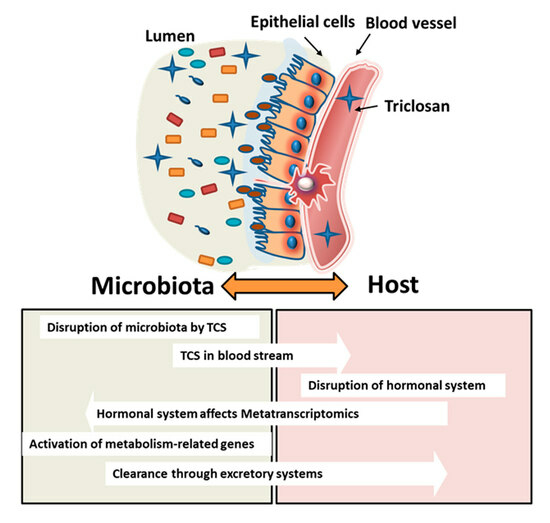
Graphical abstract
Open AccessArticle
Exposure and Health Risks Posed by Potentially Toxic Elements in Soils of Metal Fabrication Workshops in Mbarara City, Uganda
by
Eunice Nuwamanya, Denis Byamugisha, Caroline K. Nakiguli, Christopher Angiro, Alice V. Khanakwa, Timothy Omara, Simon Ocakacon, Patrick Onen, Daniel Omoding, Boniface Opio, Daniel Nimusiima and Emmanuel Ntambi
J. Xenobiot. 2024, 14(1), 176-192; https://doi.org/10.3390/jox14010011 - 30 Jan 2024
Cited by 1
Abstract
►▼
Show Figures
Metal fabrication workshops (MFWs) are common businesses in Ugandan cities, and especially those producing metallic security gates, window and door frames (burglar-proof), and balcony and staircase rails. The objective of this study was to comparatively assess the pollution levels and potential health risks
[...] Read more.
Metal fabrication workshops (MFWs) are common businesses in Ugandan cities, and especially those producing metallic security gates, window and door frames (burglar-proof), and balcony and staircase rails. The objective of this study was to comparatively assess the pollution levels and potential health risks of manganese (Mn), chromium (Cr), cadmium (Cd), lead (Pd) and nickel (Ni) in pooled surface soil samples from four 5-, 7-, 8-, and 10-year-old MFWs (n = 28) and a control site (n = 8) in Mbarara City, Uganda. The concentration of the potentially toxic elements (PTEs) was determined using inductively coupled plasma–optical emission spectrometry. Contamination, ecological, and human health risk assessment indices and models were used to identify any risks that the PTEs could pose to the pristine environment and humans. Our results showed that PTE pollution of soils is occuring in the MFWs than at the control site. The mean concentrations of the PTEs (mg kg−1) in the samples were: Mn (2012.75 ± 0.23–3377.14 ± 0.31), Cr (237.55 ± 0.29–424.93 ± 0.31), Cd (0.73 ± 0.13–1.29 ± 0.02), Pb (107.80 ± 0.23–262.01 ± 0.19), and Ni (74.85 ± 0.25–211.37 ± 0.14). These results indicate that the PTEs could plausibly derive from the fabrication activities in these workshops, which is supported by the high values of contamination factors, index of geoaccumulation, and the overall increase in pollution load indices with the number of years of operation of the MFWs. Human health risk assessment showed that there are non-carcinogenic health risks that could be experienced by children who ingest PTEs in the soils from the 7-, 8- and 10-year-old MFWs. The incremental life cancer risk assessment suggested that there are potential cancerous health effects of Cd and Ni that could be experienced in children (who ingest soils from all the four MFWs) and adults (ingesting soils from the 8- and 10-year-old MFWs). This study underscores the need to implement regulatory guidelines on the operation and location of MFWs in Uganda. Further research should be undertaken to investigate the emission of the PTEs during welding operations in the MFWs.
Full article
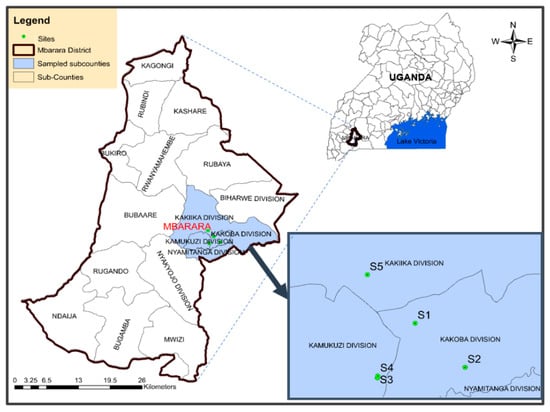
Figure 1
Highly Accessed Articles
Latest Books
E-Mail Alert
News
Topics
Topic in
JoX, Toxins
Toxins in Medical Toxicology
Topic Editors: Ioana Marina Grinţescu, Liliana Mirea, Radu Ciprian Ţincu, Dan E. CorneciDeadline: 9 August 2024
Topic in
JMSE, JoX, Microplastics, Toxics, Water
Plastics, Water-Soluble Polymers and Rubberized Materials: Ecotoxicological Aspects in the Aquatic Environments
Topic Editors: Stefano Magni, François GagnéDeadline: 31 August 2024
Topic in
Antioxidants, JoX, Metabolites, Molecules, Toxics
Recent Advances in Veterinary Pharmacology and Toxicology
Topic Editors: Chongshan Dai, Jichang LiDeadline: 31 December 2024
Topic in
Environments, IJMS, JoX, Pollutants, Toxics
Disease Risks and Toxic Pathway from Environmental Chemical Exposure
Topic Editors: Zhenglu Wang, Chuang Liu, Jiana LiDeadline: 30 March 2025

Conferences
Special Issues
Special Issue in
JoX
Crosslink Between Kidney Homeostasis and Xenobiotics Action
Guest Editors: Guido Gembillo, Wisit Cheungpasitporn, Rossella SiligatoDeadline: 30 April 2024
Special Issue in
JoX
Pharmaceuticals and Personal Care Products: From Exposure to Impacts on Human, Animal and Ecosystem Health towards an Integrated One Health Approach
Guest Editor: Noureddine BouaïchaDeadline: 28 June 2024
Special Issue in
JoX
Selected Papers from the 10th International Conference on Environmental Management, Engineering, Planning and Economics (CEMEPE 2023) and SECOTOX Conference
Guest Editors: Petros Samaras, Dorothea S. Kasiteropoulou, Christina EmmanouilDeadline: 1 October 2024
Special Issue in
JoX
The Role of Endocrine-Disrupting Chemicals in the Human Health
Guest Editor: Elisa CairraoDeadline: 30 November 2024




